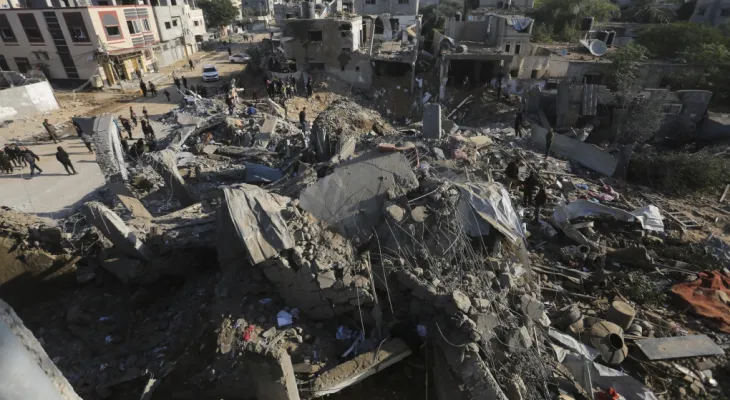Search here
Newspaper
Search here

Arab Canada News
News

Published: December 4, 2023
The Israeli army renewed its calls today, Monday, for a mass evacuation from the town of Khan Yunis in the southern Gaza Strip, where tens of thousands of displaced Palestinians have taken refuge in recent weeks, as it expanded its ground offensive and bombed targets across Gaza.
The expanded operations, following the end of a week-long ceasefire, aim to eliminate Hamas rulers in Gaza, whose attack on Israel on October 7 sparked the deadliest Israeli-Palestinian violence in decades. The war has already killed thousands of Palestinians and displaced more than three-quarters of the Gaza Strip's 2.3 million population, who no longer have safe places to go.
It appears that Israel, already under increasing pressure from its major ally, the United States, is racing to deliver a fatal blow to Hamas — if possible, given the group's deep roots in Palestinian society — before any new ceasefire. However, the increasing number of fighting, which Palestinian health officials say has killed several hundred civilians since the truce ended on Friday, is likely to increase international pressure to return to the negotiating table, and may render larger parts of the isolated area uninhabitable.
The ground offensive has turned much of the north, including large areas of Gaza City, into a barren land filled with rubble. Hundreds of thousands have fled to the south, where parts could face the same fate, and both Israel and neighboring Egypt have refused to accept any refugees.
Residents said they heard air raids and explosions in Khan Yunis and its surroundings overnight and into Monday after the army dropped leaflets warning people to move south towards the Egyptian border. In a post in Arabic on social media early Monday, the army again ordered the evacuation of nearly twenty neighborhoods in and around Khan Yunis.
While Israel has conducted air raids across the area since the start of the war, it is unclear where the ground forces are operating. An Associated Press reporter in the central town of Deir al-Balah heard gunfire and tank noises nearby but saw no immediate visual confirmation. The army rarely comments on troop deployments.
Admiral Daniel Hagari, the Israeli army spokesperson, confirmed that the army is pursuing Hamas "with maximum force" in the north and south and said it is trying to minimize harm to civilians.
He pointed to a map dividing southern Gaza into dozens of blocks to provide "precise instructions" to residents about where to evacuate.
However, many Palestinians have ignored previous evacuation orders, saying they do not feel any safer in the areas they were told to flee to — which have also been frequently bombed. At the same time, the army has prevented those who fled the north from returning, even during the ceasefire.
Rising number of dead and injured
The Hamas-run Ministry of Health in Gaza said the death toll in the enclave since October 7 has exceeded 15,500, along with more than 41,000 injured. The ministry does not differentiate between civilian and combatant dead but said 70% of the dead are women and children.
A Ministry of Health spokesperson confirmed that hundreds have been killed or injured since the ceasefire ended early Friday. Ashraf al-Qudra said, "The majority of the victims are still under the rubble."
Omar al-Darraawi, an administrative worker at the Al-Aqsa Martyrs Hospital in Deir al-Balah, said the hospital received 32 bodies on Friday night following Israeli airstrikes on central Gaza. Footage from the Associated Press showed women crying, kneeling over, and kissing the bodies of their loved ones.
The army said aircraft struck about 200 Hamas targets overnight while ground forces operated "in parallel" without giving details. It said forces in northern Gaza found a militant hideout in a school after it was attacked, discovering two tunnel entrances inside, one of which was booby-trapped, along with explosives and weapons.
It is not possible to independently verify battlefield reports from either side.
Israel says it does not target civilians and has taken measures to protect them, including evacuation orders. In addition to leaflets dropped over Gaza, the army has used phone calls and radio and television broadcasts to urge people to move from certain areas.
Israel says it targets Hamas militants and blames injuries to civilians on the militants, accusing them of operating in residential neighborhoods. It claims to have killed thousands of militants without providing evidence. Israel says at least 81 of its soldiers have been killed.
American pressure
The United States is pressuring Israel to avoid further mass displacement and civilian deaths, a message reinforced by Vice President Kamala Harris during a visit to the region. She also said the United States would not allow the forced deportation of Palestinians outside Gaza or the occupied West Bank, nor redrawing Gaza's borders.
However, it is unclear how far the Biden administration wants or can go in pressuring Israel to restrain the offensive, even as the White House faces increasing pressure from its allies in Congress.
The United States has pledged steadfast support for Israel since the October 7 attack, which killed more than 1,200 people, most of them civilians, including quick ammunition and other aid to Israel.
Israel has rejected U.S. proposals to transfer control of the Gaza Strip after the war to the internationally recognized Palestinian Authority as part of renewed efforts to solve the broader conflict through establishing a Palestinian state.
Hopes for another temporary truce faded after Israel convened its negotiators at home over the weekend. Hamas said talks on releasing more hostages held by Palestinian militants since October 7 should be tied to a permanent ceasefire.
The previous truce facilitated the release of 105 of about 240 Israeli and foreign hostages held in Gaza since the October 7 attack and the release of 240 Palestinians imprisoned in Israel. Most of those released by both sides were women and children.
Comments